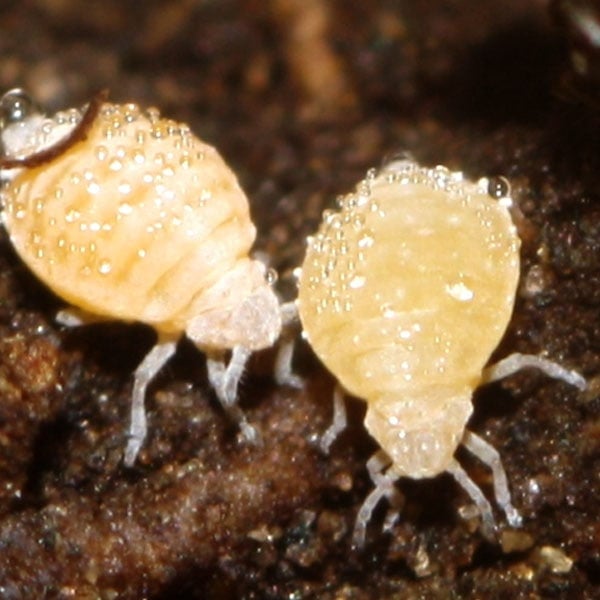Does this also mean I should probably harvest my entire flowering crop?
Home »
Pest Problem Solver »
Houseplant Pests » Root Aphid
Root Aphid
How to spot and organically control root aphids. A growing pest of greenhouse and garden plants.
Share on TwitterShare on FacebookShare on Pinterest
Share on Flip it
Root aphids — aphids that stay at or above the soil line — are from the family
Phylloxera, a near-cousin of aphids. They are an escalating problem, especially among indoor growers, and spreading through parts of the country where they haven’t been seen before. They’re hard to spot and unlike small colonies of
green and other aphids found on stems and leaves, root aphids are more likely to get out of control. They can multiply quickly, unseen, and sap enough vigor from your plants to kill them.
Table of Contents
Bat Benefits for Your Garden__RWBUIiUoDc_1080p
Identification
Because they’re small — about the size of a mite — and often colored to blend with roots and soil,
Phylloxera is hard to spot. Often, growers will see the white, waxy material that the aphids secrete, a chalkier type of the honeydew secreted by other aphids. Their bodies are more pear-shaped than oval as are
mealybugs. They’re about the same size or slightly smaller than stem-and-leaf aphids with shorter legs and antennae. They come in a variety of colors, including pink, but are mostly white and brown. They’re commonly confused with the larger mealy bugs, because of the white substance they spread. In their winged stage, they can be confused with
fungus gnats. Like other aphids, they have small cornicals or “tail pipes” at the end of their abdomen which also distinguishes them from mealybugs.
Because of their size and below-soil habitat they can go unnoticed, even through one or more grow cycles. They can be spotted attached to the sides of grow cups when growers take the trouble to look. Root aphid damage is often mistaken for other problems, especially nutrient deficiencies. Plants that appear to be suffering from magnesium or iron deficiency should be checked carefully for root aphids.
In outdoor gardens, root aphids may be accompanied by
ants. Once established in soil or hydroponic systems, root aphids are difficult to completely remove.
Lifecycle
Root aphids are surprisingly adaptable and their lifecycle can vary tremendously. They reproduce asexually during the growing season. Eggs over-winter in soil or, in warm seasons, are attached to leaves and stems above the root line where they hatch and fall to the ground. The aphid bores into the root, creating scars that leave plants vulnerable to mildew and disease. As infestations increase, “crawlers” will move up the stem to feed. Once a plant is nearly destroyed, some root aphids will develop wings that enable them to seek new plants to attack. In the fall, winged aphids, now male and female, mate in brush and trees and produce more eggs. Ants are known to carry aphids from exhausted plants to un-colonized ones.
Damage
Damage from root aphids is usually visible in a lack of vigor from plants. Withered, curled, and yellow leaves, similar to signs of nutrient deficiencies, appear and plants fail to reach the size of uninfested plants. Fruits and blossoms on aphid infested plants will be small, stunted, and generally less desirable as nutrition is siphoned away from them.
Attacks from root aphids can leave plants vulnerable to root rot, mildew, and disease.
Visible symptoms, like yellowing leaves, often lead growers to consider adding certain minerals, usually magnesium, to their nutrient mixture, often with no result.
In addition to greenhouse and garden perennials, various types of root aphids attack rice crops, the roots of a variety of trees including fir, walnut, and hickory. Root aphids can also cause problems for perennial herbs, including those grown in pots.
Root Aphid Control
Detecting the first signs of root aphids, especially when
growing indoors, is crucial to saving your plants vegetating and fruiting abilities. At a certain point, usually sooner rather than later, affected plants and containers should be removed from the grow space completely and destroyed.
Waiting for fruits or flowers to mature in an attempt to save something of a crop is not advised. This only gives root aphids a chance to inoculate themselves into your entire grow area. It’s best to start over, sanitizing all containers and growing equipment that’s been used. Indoor growers should clean their entire grow space.

